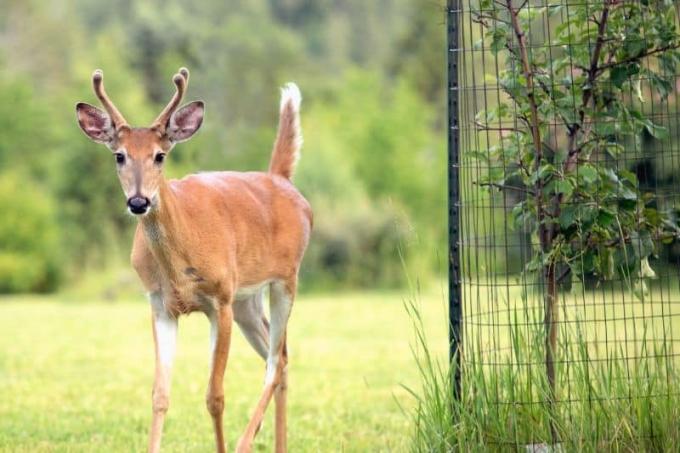
Not only in the country, even in the big city, garden trees are not safe from voracious animals. Especially in winter, deer and wild rabbits enjoy the bark. How to protect trees from deer browsing.
In a nutshell
- Keep game away with suitable wire mesh fences or dense thorn hedges
- Cover logs with cuffs, protectors or wire cages
- Coat trunks with whitewash or other non-toxic deterrents
- young trees particularly endangered
- Always cover larger wounds and deer bites in winter
Table of contents
- Protect trees from deer browsing
- 1. Mechanical tree protection
- 2. deterrent
- 3. offer food
- Treating deer browsing on trees
- frequently asked Questions
Protect trees from deer browsing
A game browsing can be easily prevented by mechanical or chemical means. In winter in particular, however, you should also bear in mind that the animals will enter your garden out of sheer lack of food and nibble on the trees there. If you offer deer and wild rabbits suitable food, then they leave the fruit and ornamental trees alone. Here are some tips to protect trees from deer browsing.
1. Mechanical tree protection

with a suitable one Fence you can keep wild animals out of your garden. So that wild rabbits, Deer and red deer have no chance of entering, should you
- as close-meshed as possible (maximum four centimetres)
- at least 190 centimeters high
- reaching at least 40 centimeters deep into the ground
Choose chain link fence.
A notice: Dense thorn hedges, such as barberry and hawthorn, can also keep deer and red deer away, but not wild rabbits. Your trees may still be at risk of being browsed by game, but to a lesser extent.
trunk protection
If building such a fence is not an option, perhaps due to existing building codes, then you should install individual protection for each tree. So-called trunk protectors or cuffs are commercially available for this purpose, which are made of solid plastic and are simply placed around the tree trunk.

A notice: Make sure these are open on one side so the trunk can continue to grow in thickness.
wire cage
Alternatively, you can wrap the trunk in a wire cage to protect the tree from deer browsing. To do this, proceed as follows:
- drive three to four wooden posts firmly into the ground
- wrap fine wire around it
- fasten well (e.g. B. with cable ties)
- Wire from the ground to the end of the trunk
The advantage of such a wire cage is that the tree has more space to grow in it.
Tip: Instead of wire mesh or plastic cuffs, you can also use reed mats, which you wrap and fasten around the tree trunks in winter. These not only protect against browsing by game, but also against the cold in the case of sensitive plants.
2. deterrent
Deterrents are chemical agents that are used to coat the trunk, for example. These agents usually contain smells or tastes that wild animals find unpleasant, so that deer and co garden trees Take distance and look for their food somewhere else.

Classic is about the white lime paint for fruit trees, who does not taste deer and red deer. Lime also has the pleasant side effect of rendering pests that overwinter in the bark harmless. It is therefore particularly recommended for apple trees plagued by the codling moth.
Other deterrents, on the other hand, rely on a deterrent effect, such as the "wild stop" based on blood meal. Deer and other herbivores are put off by the smell of blood, which is barely perceptible to us humans. After all, the predator could still be lurking nearby.
Tip: Roses and berry bushes, on the other hand, can be easily dusted with stone dust. This has a bitter taste, which is why plants treated with it are avoided. However, stone flour has the disadvantage that you have to repeat the treatment over and over again: after a downpour, the protective layer is washed off.
3. offer food
Especially in snowy winters, the risk of being bitten by a game can be high despite various Measures are increasing because deer and wild rabbits simply cannot find enough food and are hungry Suffer.

To protect your trees from deer browsing, distract the animals with hay and feed branches, which you can place in suitable places. But be careful: Do not feed any grain, leftover vegetables or the like, as this too rats and mice attracts!
Treating deer browsing on trees
Whether damage caused by game browsing has to be treated depends on three factors:
- season
- extent and size of the injury
- age of the tree
If game bites occur in winter, the injuries should always be covered. A bandage made of raffia or jute, for example, is suitable for this. The covering serves to keep frost and moisture out of the wound - frost can cause more damage by expanding, moisture in turn leads to rot and fungal diseases.

It doesn't matter what time of year: You always have to treat young trees with tender bark when they are bitten by game. They still lack the resilience of older trees, where minor wounds usually heal on their own. If there is no frost, cover larger wounds with one wound closure agent away. Tree resin is suitable for this. If necessary, the wound should be cut out beforehand so that there are smooth edges. These heal cleaner.
Tip: Disinfect the wound with a disinfectant before treatment to kill any pathogens.
frequently asked Questions
In the garden, mainly fruit trees are endangered by deer browsing, whereby apple trees and cherries seem to be particularly popular with deer and red deer. In general, the animals like trees and shrubs with a high proportion of essential oils and classic forage crops. These include juniper, rowan berries and other wild fruit trees, many types of conifers (especially firs!) as well as oak, beech, hornbeam and maple.
Young trees are particularly at risk from browsing by game. These have not yet developed a thick bark to protect the trunk. In addition, they are often not just nibbled on, but eaten whole or bent over in the heat of the moment. Deer browsing is also dangerous in winter or early spring, because frost penetrating the wounds can cause further, irreparable damage.
There are various causes that lead to deer browsing. A common reason is that there are a lot of deer, deer, wild boar, etc. there, which leads to a competitive situation with regard to food and the animals therefore switch to gardens. Such a situation also arises in snowy winters, since the game can no longer find sufficient food in its traditional territories and therefore sets out on migration.
